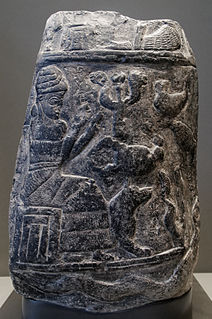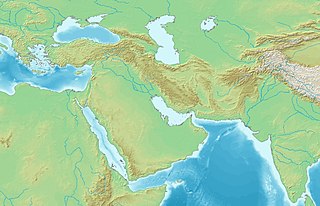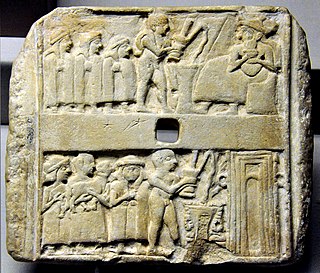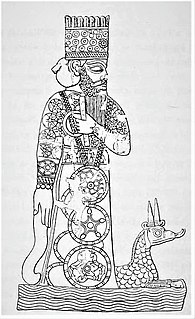
Enlil, later known as Elil, is an ancient Mesopotamian god associated with wind, air, earth, and storms. He is first attested as the chief deity of the Sumerian pantheon, but he was later worshipped by the Akkadians, Babylonians, Assyrians, and Hurrians. Enlil's primary center of worship was the Ekur temple in the city of Nippur, which was believed to have been built by Enlil himself and was regarded as the "mooring-rope" of heaven and earth. He is also sometimes referred to in Sumerian texts as Nunamnir. According to one Sumerian hymn, Enlil himself was so holy that not even the other gods could look upon him. Enlil rose to prominence during the twenty-fourth century BC with the rise of Nippur. His cult fell into decline after Nippur was sacked by the Elamites in 1230 BC and he was eventually supplanted as the chief god of the Mesopotamian pantheon by the Babylonian national god Marduk. The Babylonian god Bel was a syncretic deity of Enlil, Marduk, and the shepherd deity Dumuzid.

Mercury is a major god in Roman religion and mythology, being one of the 12 Dii Consentes within the ancient Roman pantheon. He is the god of financial gain, commerce, eloquence, messages, communication, travelers, boundaries, luck, trickery and thieves; he also serves as the guide of souls to the underworld.

Nergal, Nirgal, or Nirgali is a deity that was worshipped throughout ancient Mesopotamia with the main seat of his worship at Cuthah represented by the mound of Tell-Ibrahim. Other names for him are Erra and Irra.

Elam was an ancient civilization centered in the far west and southwest of modern-day Iran, stretching from the lowlands of what is now Khuzestan and Ilam Province as well as a small part of southern Iraq. The modern name Elam stems from the Sumerian transliteration elam(a), along with the later Akkadian elamtu, and the Elamite haltamti. Elamite states were among the leading political forces of the Ancient Near East. In classical literature, Elam was also known as Susiana, a name derived from its capital Susa.

Ninurta (Sumerian: 𒀭𒊩𒌆𒅁: DNIN.URTA, meaning of this name not known), also known as Ninĝirsu (Sumerian: 𒀭𒊩𒌆𒄈𒋢: DNIN.ĜIR2.SU, meaning “Lord of Girsu”), is an ancient Mesopotamian god associated with farming, healing, hunting, law, scribes, and war who was first worshipped in early Sumer. In the earliest records, he is a god of agriculture and healing, who releases humans from sickness and the power of demons. In later times, as Mesopotamia grew more militarized, he became a warrior deity, though he retained many of his earlier agricultural attributes. He was regarded as the son of the chief god Enlil and his main cult center in Sumer was the Eshumesha temple in Nippur. Ninĝirsu was honored by King Gudea of Lagash (ruled 2144–2124 BC), who rebuilt Ninĝirsu's temple in Lagash.

Anzû, also known as dZû and Imdugud, is a lesser divinity or monster in several Mesopotamian religions. He was conceived by the pure waters of the Apsu and the wide Earth, or as son of Siris. Anzû was depicted as a massive bird who can breathe fire and water, although Anzû is alternately depicted as a lion-headed eagle.

The Eye of Ra or Eye of Re is a being in ancient Egyptian mythology that functions as a feminine counterpart to the sun god Ra and a violent force that subdues his enemies. The Eye is an extension of Ra's power, equated with the disk of the sun, but it also behaves as an independent entity, which can be personified by a wide variety of Egyptian goddesses, including Hathor, Sekhmet, Bastet, Wadjet, and Mut. The Eye goddess acts as mother, sibling, consort, and daughter of the sun god. She is his partner in the creative cycle in which he begets the renewed form of himself that is born at dawn. The Eye's violent aspect defends Ra against the agents of disorder that threaten his rule. This dangerous aspect of the Eye goddess is often represented by a lioness or by the uraeus, or cobra, a symbol of protection and royal authority. The Eye of Ra is similar to the Eye of Horus, which belongs to a different god, Horus, but represents many of the same concepts. The disastrous effects when the Eye goddess rampages out of control and the efforts of the gods to return her to a benign state are a prominent motif in Egyptian mythology.

Jabru, Yabru or Yabnu was an Elamite god. According to Šurpu, Jabru's Akkadian counterpart was Anu.
Khumban was the Elamite god of the sky. His Sumerian equivalent was Enlil. He was a popular deity, and several Elamite kings, mostly from the Neo-Elamite Period, were named in honour of him.
Nahundi or Nahhundi was the ancient Elamite god of the sun and of law. His name means "creator of the day". Little else is known about this deity.
Zababa is a war god who was the tutelary deity of the city of Kish in ancient Mesopotamia. He is connected with the god Ninurta, and the symbol of Zababa − the eagle-headed staff − was often depicted next to Ninurta's symbol. Inanna and Baba are variously described as his wife. His sanctuary was the E-meteursag.
Ancient Semitic religion encompasses the polytheistic religions of the Semitic peoples from the ancient Near East and Northeast Africa. Since the term Semitic itself represents a rough category when referring to cultures, as opposed to languages, the definitive bounds of the term "ancient Semitic religion" are only approximate.

Marduk-apla-iddina I, contemporarily written in cuneiform as dAMAR.UTU-IBILA-SUM-na and meaning in Akkadian: "Marduk has given an heir", was the 34th Kassite king of Babylon ca. 1171–1159 BC. He was the son and successor of Melišipak, from whom he had previously received lands, as recorded on a kudurru, and he reigned for 13 years, during a time when The Dark Ages cast a heavy cloud over the contemporary events.

Tukulti-Ninurta I was a king of Assyria during the Middle Assyrian Empire. He is known as the first king to use the title "King of Kings".

The Dynasty of Isin refers to the final ruling dynasty listed on the Sumerian King List (SKL). The list of the Kings Isin with the length of their reigns, also appears on a cuneiform document listing the kings of Ur and Isin, the List of Reigns of Kings of Ur and Isin.

Sumerian religion was the religion practiced and adhered to by the people of Sumer, the first literate civilization of ancient Mesopotamia. The Sumerians regarded their divinities as responsible for all matters pertaining to the natural and social orders.

Adad-šuma-uṣur, inscribed dIM-MU-ŠEŠ, meaning "O Adad, protect the name!," and dated very tentatively ca. 1216–1187 BC, was the 32nd king of the 3rd or Kassite dynasty of Babylon and the country contemporarily known as Karduniaš. His name was wholly Babylonian and not uncommon, as for example the later Assyrian King Esarhaddon had a personal exorcist, or ašipu, with the same name who was unlikely to have been related. He is best known for his rude letter to Aššur-nirari III, the most complete part of which is quoted below, and was enthroned following a revolt in the south of Mesopotamia when the north was still occupied by the forces of Assyria, and he may not have assumed authority throughout the country until around the 25th year of his 30-year reign, although the exact sequence of events and chronology remains disputed.
Shu-Ilishu was the 2nd ruler of the dynasty of Isin. He reigned for 10 years Shu-Ilishu was preceded by Išbi-erra. Iddin-Dagān then succeeded Shu-Ilishu. Shu-Ilishu is best known for his retrieval of the cultic idol of Nanna from the Elamites and its return to Ur.

Napirisha was an Elamite deity from the region of Anshan, and was the main deity of the kingdom from at least the late 3rd millennium BCE. In Elamite, his name means "Great (-ša) God (napir)"; in cuneiform texts, the word is written using the ideogram GAL, which was without a correct interpretation for some time.

The Statue of Marduk, also known as the Statue of Bêl, was the physical representation of the god Marduk, the patron deity of the ancient city of Babylon, traditionally housed in the city's main temple, the Esagila. There were seven statues of Marduk in Babylon, but 'the' Statue of Marduk generally refers to the god's main statue, placed prominently in the Esagila and used in the city's rituals. This statue was nicknamed the Asullḫi and was made of a type of wood called mēsu and covered with gold and silver.













